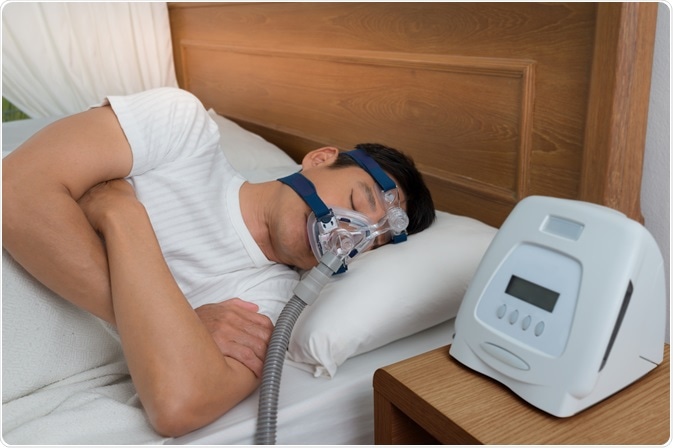Obstructive sleep apnea (OSA) is caused by an obstruction of the airways and leads to characteristic signs of disturbed breathing and pauses during sleep. There are various different types of sleep apneas but obstructive sleep apnea is the most common.

Image Credit: sbw18 / Shutterstock
Pathophysiology
Obstructive sleep apnea is usually caused by relaxation of the throat muscles while an individual sleeps, leading to narrowing of the airway and disruption to the normal flow of air when breathing.
Apnea refers to the complete obstruction of the airway, causing the inhibition of breathing for at least ten seconds. Hypopnea is a partial blockage of the airway, reducing the airflow by at least 50% for more than ten seconds.
These episodes typically occur repeatedly throughout the night while the individual sleeps, who may not be aware of the condition. The lack of oxygen to the brain can disrupt the sleep cycle leading to a lighter sleep or wakefulness, in order to reopen the airways for normal breathing. In severe cases, individuals may experience sleep apnea every one or two minutes throughout the night.
Risk Factors
Although it is normal for the muscles in the throat to relax slightly during sleep, it does not usually disrupt the sleep cycle. There are certain factors that are associated with a higher risk of over-relaxation of the muscles and obstructive sleep apnea, such as:
- Obesity
- A large neck
- Abnormal structure of the neck
- Taking medicines with a sedative effect
- Smoking or alcohol consumption before bed
Men are more likely to be affected than women and the symptoms most commonly present between the age of 30 and 60.
Symptoms
Many individuals with obstructive sleep apnea are not aware of the condition and the primary symptom that they notice is fatigue during the day, as a result of their disturbed sleep.
Often, their partner who has noticed changes in their breathing while they sleep alerts them to the symptoms. These signs may include:
- Loud snoring
- Noisy breathing
- Labored breathing
- Gasping or snorting between episodes of apnea.
Management
Obstructive sleep apnea can be treated with various techniques, both with lifestyle changes and medical interventions. The treatment aim is to reduce the symptoms of the condition, but the condition is chronic in most cases.
Initially, patients with OSA should aim to lose any excess weight if they are obese or overweight, to help reduce the pressure on their throat. As some medications such as sleeping tablets can cause the condition, the necessity of these should be reconsidered. Additionally, avoiding or moderating the intake of alcohol and smoking before bedtime is important.
A continuous positive airway pressure (CPAP) device can be used to prevent the closure of the airways during sleep. It works with a mask that continually pushed compressed air through the airway, keeping it open.
A mandibular advancement device (MAD) can also help to improve breathing. The device is worn around the teeth of the patient and holds the jaw and tongue forward, opening up the throat and increasing the space to breathe.
In some cases, a structural problem is causing the symptoms of obstructive sleep apnea and surgery may be required to correct this but is not routinely required.
Prevention
The prevention of obstructive sleep apnea involves the avoidance of the known risk factors for the condition. Therefore, the following techniques may help to prevent OSA:
- Maintain a healthy weight or lose excessive weight
- Limit alcohol consumption before bedtime
- Stop smoking, particularly before bedtime
- Avoid using sleeping tablets or other tranquilizers
References
Further Reading